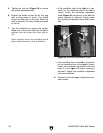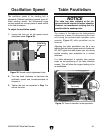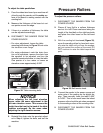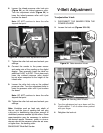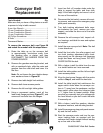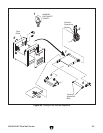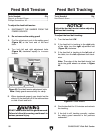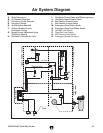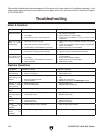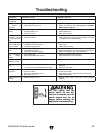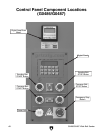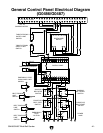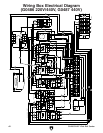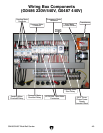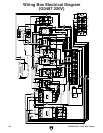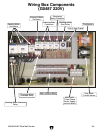
-38- G0486/G0487 Wide Belt Sander
Troubleshooting
Review the troubleshooting and procedures in this section to fix your machine if a problem develops. If you
need replacement parts or you are unsure of your repair skills, then feel free to call our Technical Support
at (570) 546-9663.
Motor & Electrical
Symptom Possible Cause Possible Solution
Motor will not start.
1. Limit switch or emergency stop is at fault.
2. Low voltage.
3. Open circuit in motor or loose connections.
1. Correct situation that caused limit switch to engage, reset
the emergency stop button.
2. Check power line for proper voltage.
3. Inspect all lead connections on motor for loose or open
connections.
Motor will not start;
fuses or circuit
breakers blow.
1. Short circuit in line cord or plug.
2. Short circuit in motor or loose connections.
3. Incorrect fuses or circuit breakers in power line.
1. Inspect cord or plug for damaged insulation and shorted
wires.
2. Inspect all connections on motor for loose or shorted termi
-
nals or worn insulation.
3. Install correct fuses or circuit breakers.
Motor overheats. 1. Motor overloaded.
2. Air circulation through the motor restricted.
1. Reduce load on motor.
2. Clean out motor to provide normal air circulation.
Motor stalls (result
-
ing in blown fuses
or tripped circuit).
1. Short circuit in motor or loose connections.
2. Low voltage.
3. Incorrect fuses or circuit breakers in power line.
4. Motor overloaded.
1. Inspect connections on motor for loose or shorted terminals
or worn insulation.
2 Correct the low voltage conditions.
3. Install correct fuses or circuit breakers.
4. Reduce load on motor.
Machine Operations
Symptom Possible Cause Possible Solution
Machine slows
when operating.
1. Feed rate too high.
2. Depth of cut too great.
1. Feed workpiece slower.
2. Reduce depth of cut.
Loud, repetitious
noise coming from
machine.
1. Pulley set screws or keys are missing or loose.
2. Motor fan is hitting the cover.
3. V-belt is defective.
1. Inspect keys and set screws. Replace or tighten if neces
-
sary.
2. Tighten fan or shim cover.
3. Replace V-belt. Refer to the
Maintenance section.
Machine is loud,
overheats or bogs
down in the cut.
1. Excessive depth of cut.
2. Dull or dirty sanding belt.
1. Decrease depth of cut.
2. Replace or clean sanding belt.
Rounded workpiece
edges.
1. Excessive depth of cut. 1. Reduce depth of cut.
Uneven thickness
from left to right of
board.
1. Feed table not parallel to sanding roller.
2. Conveyor belt is worn.
1. Adjust the table.
2. Replace conveyor belt.
Workpiece slips on
feed belt.
1. Pressure rollers set too high.
2. Dirty
conveyor belt.
3. Conveyor belt is worn.
1. Lower pressure rollers.
2. Clean
conveyor belt.
3. Replace
conveyor belt.
Straight strip
of notches on
workpiece.
1. Pressure rollers are dirty or damaged. 1. Clean or repair pressure rollers.
Snake shaped
marks on
workpiece.
1. Sanding belt damaged or dirty. 1. Clean or replace sanding belt.



